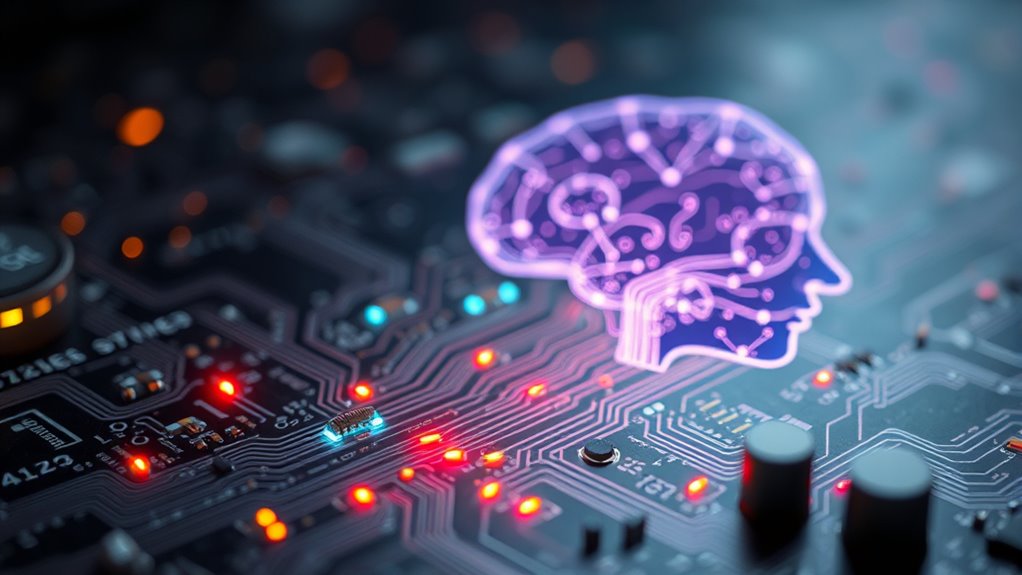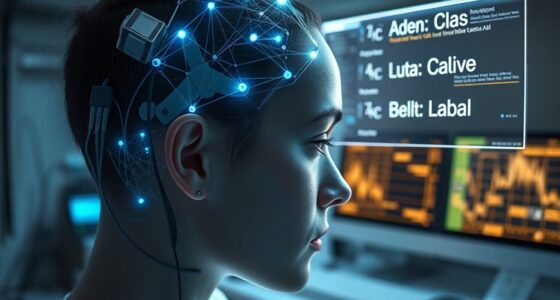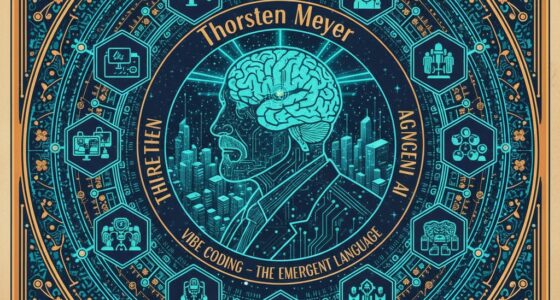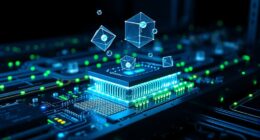To understand artificial intelligence, you need to grasp how it learns and adapts. AI uses algorithms that improve their performance by analyzing large datasets to find patterns. This process is iterative, allowing machines to refine their abilities over time. Neural networks mimic the human brain, processing information through interconnected nodes that adjust based on prediction accuracy. Recognizing how these mechanisms work reveals AI’s true potential and its impact on your daily life. There’s much more to uncover.
Key Takeaways
- AI learns through algorithms that analyze data, identifying patterns to improve performance over time.
- Machine learning, a subset of AI, allows systems to refine abilities as they process more data.
- Neural networks, inspired by the human brain, use interconnected nodes to learn complex data relationships.
- AI adapts by adjusting connection weights in neural networks based on prediction accuracy and feedback.
- The continuous evolution of AI relies on data-driven learning, enhancing its problem-solving capabilities and applications in daily life.
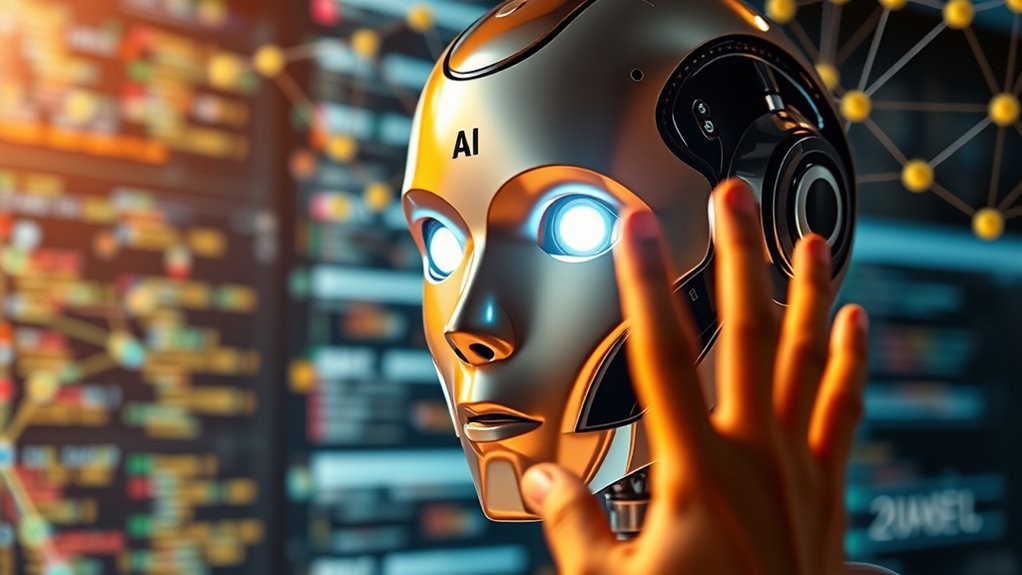
What does it really mean to understand artificial intelligence? At its core, it’s about grasping how machines can learn from data and adapt their behavior over time. You might think of AI as a powerful tool that mimics human thought processes, but it’s essential to explore deeper into the mechanisms that drive this technology. Machine learning and neural networks are pivotal components in this exploration, and understanding them can give you a clearer picture of AI’s capabilities.
Understanding artificial intelligence means grasping how machines learn and adapt, revealing the intricate mechanisms that drive this transformative technology.
When you engage with AI, you’re often interacting with systems that utilize machine learning. This is a subset of AI where algorithms improve their performance as they are exposed to more data. Imagine teaching a child to recognize animals; the more examples they see, the better they become at identifying them. Similarly, in machine learning, algorithms analyze vast amounts of data, identify patterns, and make predictions based on those patterns. It’s this iterative process that allows AI to refine its abilities over time.
Now, let’s talk about neural networks, another essential aspect of AI. Think of neural networks as a simplified model of the human brain, composed of interconnected nodes or neurons. Each node processes information and passes it to the next, allowing the network to learn complex relationships within the data. When you feed a neural network a dataset, it adjusts the weights of connections between neurons based on the accuracy of its predictions. This adjustment is akin to learning from mistakes, enabling the network to enhance its performance gradually.
As you explore further into understanding AI, you’ll find that these technologies are not just theoretical constructs; they’re actively shaping our daily lives. From recommendation systems on streaming platforms to virtual assistants, machine learning and neural networks are at the heart of many innovations. You might not realize it, but they’re often working behind the scenes, analyzing your preferences and improving your experience. Furthermore, AI’s capabilities are enhanced by predictive analytics for small business, which optimize decision-making and increase efficiency.
In essence, grasping artificial intelligence means recognizing how machine learning and neural networks empower systems to learn and adapt. It’s not just about knowing that AI exists; it’s about understanding the intricate processes that allow it to function. As you continue your journey in this field, remember that the real magic lies in the algorithms that learn from data, making AI a powerful ally in solving complex problems and enhancing our lives.
Frequently Asked Questions
What Are the Ethical Concerns Surrounding AI Development?
The ethical concerns surrounding AI development include privacy concerns and accountability issues. You’ll see that AI can collect and analyze vast amounts of personal data, potentially compromising individual privacy. Furthermore, when AI systems make decisions, it’s often unclear who’s responsible for those choices, raising accountability questions. If something goes wrong, you might wonder: who’s to blame—the developer, the user, or the AI itself? These issues highlight the need for clear ethical guidelines.
How Does AI Impact Job Markets and Employment?
AI considerably impacts job markets and employment by driving automation in various sectors. You might notice that many routine jobs are at risk of automation, leading to skill displacement among workers. While AI creates new opportunities, it often requires different skills that not everyone possesses. To stay relevant, you’ll need to adapt and upskill, ensuring you meet the demands of an evolving job landscape shaped by technological advancements.
Can AI Systems Become Sentient or Conscious?
Imagine a robot chatting with you, sharing thoughts and feelings like a friend. You might wonder if it’s truly sentient. The sentience debate argues whether AI can develop artificial consciousness. While current systems like chatbots mimic conversation, they don’t possess self-awareness or emotions. So, despite fascinating advancements, AI hasn’t reached a level of true consciousness. For now, it’s a tool, not a sentient being, and its understanding remains fundamentally different from yours.
What Is the Difference Between AI, Machine Learning, and Deep Learning?
AI refers to any system that mimics human intelligence, while machine learning is a subset that uses algorithms to analyze data and improve over time. Deep learning, on the other hand, involves neural networks that simulate the brain’s structure, allowing for more complex problem-solving. fundamentally, you can think of AI as the broad concept, machine learning as its practical application, and deep learning as a specialized technique within that evolution.
How Do Biases in Data Affect AI Decision-Making?
When it comes to AI decision-making, you’ll find that biases in data can be quite the sneaky little gremlins. They can distort outcomes, leading to unfair or inaccurate results. By ensuring high data quality and implementing bias mitigation strategies, you help AI make fairer decisions. Remember, the cleaner and more representative your data is, the better your AI’s judgment will be. It’s all about giving it the best tools to work with!
Conclusion
As you dive deeper into the dynamic world of artificial intelligence, remember that AI isn’t just a tool; it’s a transformative technology. By learning and adapting, it shapes solutions and sparks innovations. Stay curious and keep exploring this enthralling field, where algorithms and advancements collide. Embrace the evolution of intelligence, and you’ll uncover endless possibilities waiting to be discovered. The future’s bright, and with AI by your side, you’re on the brink of breakthroughs!

